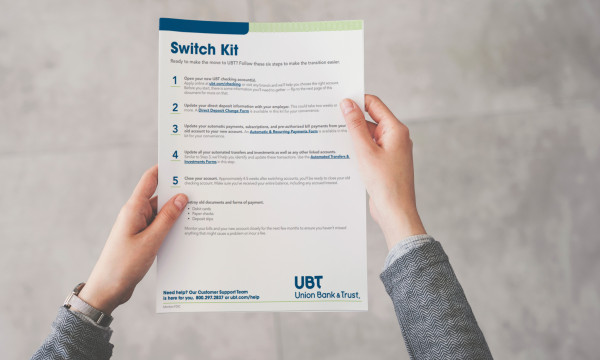Banking 101: The ins and outs of banks

A good financial education is the key to healthier finances — and we believe it should be accessible to everyone. That’s why we created our Financial Literacy Program, which aims to teach basic, foundational financial topics starting from the ground up — literally. Because, for some folks, even setting foot in a bank is new. So, let’s talk about the basics of banking: who you’ll see when you walk into a bank, what goes on inside, and what services are offered. We’ll talk about security, how UBT is keeping your money safe, and why it’s important. Let’s get started!
Visiting UBT
Your first stop when banking with UBT is visiting a branch, which is a physical location of a bank. At UBT, we have several branches all over Lincoln, across the state of Nebraska, and even into Kansas. Choosing a branch is usually a decision based on location, but never feel like you have to stick to just one. Stop in to whichever branch is convenient at the time — you’re welcome at any of them!
When you stop by a branch, you can either go inside the lobby or stay in your car and go through the drive-thru. Drive-thru lanes are located on the outside of most branches. They’re super convenient once you’ve opened your account(s), as you can do most of your everyday banking without getting out of your car. You simply pull up and speak directly to one of our friendly tellers! Basic services, such as withdrawals, deposits, and loan payments, are offered through the drive-thru window. This is a great option in our currently social-distanced world; however, not all branches have drive-thru services, so make sure you check online or call that location to be sure.
Who’s in a branch?
If you do head into a branch, you’ll find several people there ready to help. Depending on the size of branch, it might be staffed with some combination of support staff, tellers, personal bankers, loan officers, and branch managers, all of whom have their own responsibilities and areas of expertise.
A receptionist or other member of support staff might be the first person you’ll have contact with. They’ll ask you a few questions about what brings you in that day so they can point you to the right person. Tellers are the folks behind the counter ready to take your deposits and process withdrawals, give you your balance, and answer most account questions.
When you’re ready to open an account, want to sign up for a debit or credit card, or need help walking through a service that is new to you (such as UBTgo, our online banking platform), you’ll meet with a personal banker. A personal banker’s job is to assist you with your banking goals and recommend the financial products, services, and people that can help you achieve them.
Are you looking to take out a loan? You can meet with a loan officer and talk through our many loan options, including home, auto, and other types of personal loans, and begin the application process.
Finally, you may talk to an assistant branch manager or a branch manager. They’re in charge of making sure the whole branch is running smoothly and safely, in addition to assisting bank customers with their account and loan needs.
What else can I do at a branch?
While there are some services you might request that would require contacting someone at another location to assist you (for example, mortgage loan officers may not be at all locations), there are so many services UBT can help you with at a branch, from personal and business checking accounts to various savings and retirement accounts. And once you’ve opened an account, you can go to a branch or drive-thru to make deposits, withdrawals, or account changes. You can also apply for loans or make payments, purchase gift cards, get cashier’s checks and money orders, and even cash in your spare change.
At many locations, you can also rent a safe deposit box, a secure, fireproof box that is stored in the bank’s vault. It’s tightly secured, as it’s opened and locked with two keys — one is yours, and the other belongs to the bank. It’s a great way to store important items that you might not want to keep at home, such as important documents like wills, Social Security cards, trusts, and passports; jewelry; and other valuable personal items you don’t want to lose. However, you would never want to store weapons, illegal substances or objects, or cash or currency in your safe deposit box. The size and cost of the boxes vary, but they’re available to rent at many locations — you don’t even need to be an account holder.
Security at the bank
Security is very important to UBT, as it’s our responsibility to safeguard you, our employees, your money, and your information. We take this very seriously (and we ask our customers to help keep their accounts safe by not sharing sensitive data). Our branches use many layers of security, such as secured doors, cameras, and intercoms. We ask questions to verify identity when customers are calling in or visiting the branch, meaning you’ll want to bring your ID when you visit. Regular trainings and audits ensure extra measures of employee awareness and accountability. Most of all, UBT employees want to get to know you, your family, and your banking habits — both because it helps us recognize if anything is out of the ordinary, and because caring about our customers is just part of who we are.
Now that you’ve had a very basic overview, come visit us! We’re eager to help take the mystery out of banking and help you achieve your financial goals. Visit our locations page to find a branch near you, and we hope to see you soon.
Learning Center articles, guides, blogs, podcasts, and videos are for informational purposes only and are not an advertisement for a product or service. The accuracy and completeness is not guaranteed and does not constitute legal or tax advice. Please consult with your own tax, legal, and financial advisors.




